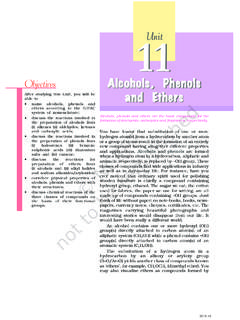Transcription of 1 Introduction to Horticulture - NCERT
1 IntroductIonHorticulture is a science, as well as, an art of production, utilisation and improvement of horticultural crops, such as fruits and vegetables, spices and condiments, ornamental, plantation, medicinal and aromatic plants. Horticultural crops require intense care in planting, carrying out intercultural operations, manipulation of growth, harvesting, packaging, marketing, storage and processing. India is the second largest producer of fruits and vegetables in the world after China. In India, about 55 60 per cent of the total population depends on agriculture and allied activities. Horticultural crops constitute a significant portion of the total agricultural produce in India.
2 They cover a wide cultivation area and contribute about 28 per cent of the Gross Domestic Product (GDP). These crops account for 37 per cent of the total exports of agricultural commodities from 1: Horticulture and ItS importance The term Horticulture is derived from two Latin words hortus, meaning garden , and cultura meaning cultivation . It refers to crops cultivated in an enclosure, , garden ction to H o rt i c u lt u re1 Chapter 111-07-2018 11:33:32 SolanaceouS crop cultivator claSS iX2 Features and importanceHorticulture crops perform a vital role in the Indian economy by generating employment, providing raw material to various food processing industries, and higher farm profitability due to higher production and export earnings from foreign exchange.
3 (a) Horticulture crops are a source of variability in farm produce and diets.(b) They are a source of nutrients, vitamins, minerals, flavour, aroma, dietary fibres, etc.(c) They contain health benefiting compounds and medicines.(d) These crops have aesthetic value and protect the environment.(e) The comparative production per unit area of horticultural crops is higher than field crops, , paddy crop gives a maximum yield of only 30 q/ha, while banana crop gives 300 450 q/ha and grapes 90 150 q/ha.(f) Fruit and plantation crops can be cultivated in places where the slope of land is uneven or undulating. Mango and cashew nut are cultivated on a large scale in hilly and hill back area of the Konkan region.
4 (g) The crops are useful for cultivation in wasteland or poor quality soil.(h) Such crops are of high value, labour intensive and generate employment throughout the year.(i) Horticultural produce serves as raw material for various industries, such as processing, pharmaceutical, perfumery and cosmetics, chemical, confectionery, oils and paints, etc.(j) They have national and international demand and are a good source of foreign status of horticultural crops in IndiaAccording to the data provided by the Government of India for 2016 17, Horticulture crops in India are being cultivated in 24 million hectares, which is about 7 per cent of India s total cropped area.
5 The annual horticultural produce is estimated around 295 million tonnes, which includes 175 million tonnes of vegetables and 92 million tonnes of fruits in noteSChapter 211-07-2018 11:33:32 Introduction to HortIculture32016 17. India is the largest producer of okra (lady s finger). Among vegetables, India ranks second in the production of potato, onion, cauliflower, brinjal and cabbage. In fruits, it is the largest producer of banana, mango, guava, lemon and papaya. Mango, walnut, grapes, banana and pomegranate are the major fruits exported, while onion, okra, bitter gourd, green chilly, mushroom and potato have more exotic demand.
6 Fruits and vegetables are mostly exported to the UAE, Bangladesh, Malaysia, the Netherlands, Sri Lanka, Nepal, the UK and Saudi : Important horticultural crops and their growing regions in IndiaStateMajor Horticultural Crop(s)NorthernHaryana Bottle gourd, marigoldHimachal PradeshApple, potatoJammu and KashmirApplePunjabCitrus fruitsUttarakhandPotatoUttar PradeshMango, banana, potato, sweet potato, watermelon, bottle gourd, jasmineRajasthanPomegranate, onion, jasmine, tuberoseWesternChhattisgarhBottle gourd, roseGoaCoconut, arecanut, cashew nut GujaratBanana, papaya, sapota, pomegranate, potato, onion, tomato, rose, marigoldMaharashtraMango, banana, grapes, citrus fruits, sapota, pomegranate, chilli, onion, rose, chrysanthemum, tuberose, marigoldMadhya PradeshCitrus fruits, papaya, pomegranate, chilli, potato, sweet potato, onion, bottle gourd, tomato, chrysanthemum, marigoldSouthernAndhra PradeshMango, banana.
7 Grapes, citrus fruits, papaya, sapota, pomegranate, coconut, chilli, watermelon, tomato, jasmine, tuberose, marigoldKarnatakaMango, banana, grapes, papaya, sapota, pomegranate, coconut, chilli, onion, watermelon, tomato, rose, chrysanthemum, jasmine, tuberose, marigoldKeralaBanana, coconut, sweet potato, chrysanthemum, jasmineChapter 311-07-2018 11:33:32 SolanaceouS crop cultivator claSS iX4 Tamil NaduBanana, papaya, sapota, coconut, chrysanthemum, jasmine, tuberoseTelanganaMango, citrus fruits, tomatoEasternAndaman and Nicobar IslandsCoconutBiharMango, chilli, potato, onion, bottle gourd West BengalCoconut, potato, sweet potato, watermelon, rose, marigoldOdishaCoconut, sweet potato, watermelon, bottle gourdNorth-easternArunachal PradeshTurmeric, gingerAssamBanana, papaya, pomegranate, coconut, tuberoseMeghalayaPapaya, arecanut, gingerSikkimGingerTripuraPapaya, arecanut, turmericSource.
8 Horticulture Statistics at a Glance 2017, National Horticulture Board, Government of IndiaProspects of horticultural crops in India Diverse agro-climatic conditions in India ensure the production of all types of fresh fruits, vegetables and medicinal plants in different parts of the country ( ). Health consciousness among people is increasing. Majority of the population in India is vegetarian. As a result, the demand of fruits and vegetables is also high. The production of horticultural commodities is far less as compared to the existing demand in the country. So, there is a vast scope to produce more horticultural crops.
9 Major areas in the country are suitable only for horticultural crops, like mango, tea, coconut and arecanut, as they are non-arable, rocky, stony, marshy, undulated and has been an increase in irrigation facilities but there are crops, which even with little watering, can survive. One only needs to ensure adequate water management. Some dry land horticultural crops, like jamun, ber, tamarind, wood apple, custard apple, ramphal, etc., can be grown on rainfed land also. Compared to other countries, agricultural labour and other agricultural inputs are far cheaper and easily Chapter 411-07-2018 11:33:32 Introduction to HortIculture5available here, which reduce the cost of production and generate more profit.
10 High return, coupled with government assistance, through various schemes and financial aid, attract the rich and poor, trained and educated people towards Horticulture . This leads to the use of intensive methods and improved technology in the production of horticultural crops. Awareness of storage and processing methods also increase the availability of the produce, job opportunity and income opportunities in Horticulture The horticultural industry offers a variety of jobs, both directly and indirectly. Many jobs require knowledge and training in Horticulture . The level of training could be vocational or at the college level. The nature of work may be indoor or outdoor.











